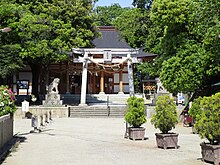Draft:Furutama-no-mikoto
| This is a draft article. It is a work in progress open to editing by anyone. Please ensure core content policies are met before publishing it as a live Wikipedia article at draft. Find sources: Google (books · news · scholar · free images · WP refs) · FENS · JSTOR · TWL Last edited by CommonsDelinker (talk | contribs) 3 months ago. (Update)
Finished drafting? or |
 Comment: really looks bleak for finding sources. No Japanese Wikipedia article exists Immanuelle ❤️💚💙 (talk to the cutest Wikipedian) 06:57, 1 October 2023 (UTC) - draft
Comment: really looks bleak for finding sources. No Japanese Wikipedia article exists Immanuelle ❤️💚💙 (talk to the cutest Wikipedian) 06:57, 1 October 2023 (UTC) - draft Comment: potential source https://www.city.kishiwada.osaka.jp/soshiki/3/mukashi6-3-yagijinjatokarausu.html Immanuelle ❤️💚💙 (talk to the cutest Wikipedian) 04:12, 1 November 2023 (UTC) - draft
Comment: potential source https://www.city.kishiwada.osaka.jp/soshiki/3/mukashi6-3-yagijinjatokarausu.html Immanuelle ❤️💚💙 (talk to the cutest Wikipedian) 04:12, 1 November 2023 (UTC) - draftFurutama-no-mikoto  Yagi Shrine a shrine that worships him
Yagi Shrine a shrine that worships himMajor cult centre Yagi Shrine Personal information Parents - Watatsumi (father)
Children Takeuioki no mikoto , Amanosakitama no mikoto , Kuroshima Isone hime, Ohonutehime
Furutama-no-mikoto (布留多摩命) is a son of Watatsumi. He is an ancestor of many clans including the Owari clan, the Yamato clan, the Kamo clan, the Kubiki Kokuzo, the Akashi Kokuzo and the Yagi clan of which he is also the Ujigami worshipped at Yagi Shrine.
He had several children including Takeuioki no mikoto|, Amanosakitama no mikoto|, Kuroshima Isone hime, Ohonutehime
Genealogy[edit]
The Amabe clan genealogy (海部氏系図, Amabe-shi Keizu) is a famous document housed at Kono Shrine. It is from early Heian period, it is considered the oldest family tree in Japan. The clan claims descent from Amenohoakari, and served as at the kuni no miyatsuko of Tanba Province before it was divided into Tamba and Tango. The document records 82 generations of descent from Amenohoakari. It was designated a National Treasure in 1972.[1]
In Shinsen Shōjiroku, the descendants of Amatsuhikone, Ame-no-hohi, and Amanomichine, together with the descendants of Amenohoakari are referred to as Tenson-zoku. The Tenson-zoku descended from Takamagahara (Plain of High Heaven) to Owari and Tanba provinces, and are considered to be the ancestors of Owari clan, Tsumori, Amabe clan, and Tanba clans.[2]
However, Toshio Hoga argues that Amabe clan genealogy, which records these four clans as descendants of Amenohoakari, is a forged document,[3] and that these clans actually descended from the sea deity Watatsumi. In addition, Owari clan's genealogy includes the great-grandson of Watatsumi, Takakuraji, as their ancestor, and he argues this is the original genealogy.[4]
Family tree[edit]
- Pink is female.
- Blue is male.
- Grey means other or unknown.
- Clans, families, people groups are in green.
References[edit]
- ^ "海部氏系図" [Amebe shikeizu] (in Japanese). Agency for Cultural Affairs. Retrieved August 20, 2020.
- ^ Hanawa, Hokiichi (1983). Shinsen Shōjiroku (新撰姓氏錄). Japan: Onkogakkai. OCLC 959773242.
- ^ Hoga, Toshio (2006). Kokuho「Amabe-shi Keizu」he no gimon, Kokigi no Heya (国宝「海部氏系図」への疑問 古樹紀之房間). Japan.
{{cite book}}: CS1 maint: location missing publisher (link) - ^ Hoga, Toshio (2006). Tango no Amabe-shi no Shutsuji to sono ichizoku, Kokigi no Heya (丹後の海部氏の出自とその一族). Japan.
{{cite book}}: CS1 maint: location missing publisher (link) - ^ "八坂刀売神(ヤサカトメノカミ". 日本の神様辞典 (Nihon no Kamisama Jiten). Archived from the original on June 25, 2017. Retrieved May 27, 2017.
- ^ Mizue, Mori (10 May 2005). "Toyotamabime". Encyclopedia of Shinto. Retrieved 2010-09-29.
- ^ Mizue, Mori (22 April 2005). "Hohodemi". Encyclopedia of Shinto. Retrieved 2010-09-29.
- ^ Mizue, Mori (12 May 2005). "Ugayafukiaezu". Encyclopedia of Shinto. Retrieved 2010-09-29.
- ^ a b Chamberlain, Basil. [SECT. LXV.—EMPEROR SŪ-JIN (PART III: STORY OF OHO-TATA-NE-KO'S BIRTH)] (The Kojiki). Read before the Asiatic Society of Japan on April 12, May 10, and June 21, 1882, reprinted in 1919. p. 219.
His Augustness Oho-tata-ne-ko ... was the ancestor of the Dukes of Miwa and of the Dukes of Kamo.

